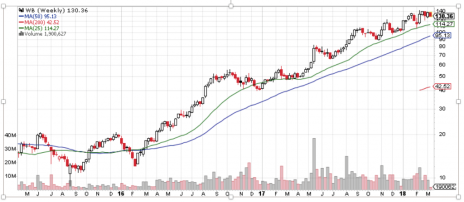It’s fun to read about your sports teams when they win, and I think it’s great to read about growth stocks when they score big. Reading about success stories can inspire you, teach you what to look for and give you the confidence you need to start looking for one of your own. My success story today is Weibo stock.
How Weibo Stock Became a Ten-Bagger
Weibo (WB) is a Chinese instant messaging platform that mimics Twitter (TWTR) in almost all regards, enabling attachments of pictures, videos, links and other content while limiting the length of texts. Despite the limit on characters, Weibo functions much more like Facebook (FB) because Chinese characters are more like words than letters, so a Weibo post could be the equivalent of 80 words. (And if the company follows Twitter in raising its character limit, a Weibo post could turn into a small essay.)
Weibo was inaugurated as a service of the Chinese web portal Sina.com in 2010 and spun off in 2014, with Sina keeping a majority stake. Weibo’s monthly active user (MAU) roster now has 392 million accounts, up 79 million from Q4 2016, with mobile device users representing 93% of MAUs. The daily active user count hit 172 million in December, an increase of 33 million from the same period in 2016.
[text_ad]
The company’s Q3 earnings report on November 7 headlined a 77% jump in revenue (after growth of 81% in Q3 and 72% in Q2), with earnings up 88%. For Weibo, that’s the first quarter of double-digit earnings growth after 12 consecutive quarters with triple-digit earnings growth. After-tax profit margins were a healthy 39%. The company has $1.79 billion in cash and cash equivalents
Weibo makes most of its money by selling advertising and marketing opportunities to customers seeking access to its user base. Given the enthusiasm Chinese consumers have shown in taking to e-commerce, it should be a growing market.
There are risks associated with Weibo, of course. The Chinese government holds all Chinese online entities responsible for the content posted by users. And while Weibo uses both automated and human screening of content, violations of the rules can result in significant sanctions, like temporary service shutdowns. And eventually, growth will have to slow down as the Chinese social media market approaches saturation.
But the real bottom line for Weibo shows up in the chart for its stock, whose symbol is WB. Any stock that can deliver a 10-bagger in less than two years is bound for the Hall of Fame, and that’s exactly what Weibo stock did, soaring from 12 in February 2016 to 142 at its peak last month. Here’s what the weekly chart looks like.
Like many Chinese stocks (also many U.S. growth stocks), WB has corrected a little since its high at 142 on February 15 and now has spent several weeks under resistance at 140. Now trading at 130, Weibo stock is back to its January price level.
Where to Find the Next Weibo
But as you can see from the chart, the stock has had plenty of pullbacks and flat patches on its long run, so it’s a fairly safe bet that the stock is taking a breather, not dropping out of the race entirely.
I’ve advised my subscribers to Cabot Global Stocks Explorer to buy WB stock several times during the last two years, jumping in when things were going well and getting shaken out during corrections. It’s now in the portfolio with a Buy rating.
If you’d like to have a trusted advisor to find stocks with the potential to become the next Weibo and help you navigate the rewarding (but challenging) waters of the fastest growing market in the world, you can get started by clicking right here.
[author_ad]

